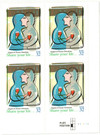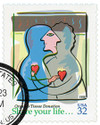
1998 32c Organ and Tissue Donation
# 3227 - 1998 32c Organ and Tissue Donation
$0.35 - $25.00
U.S. #3227
1998 32¢ Organ and Tissue Donation
1998 32¢ Organ and Tissue Donation
Issue Date: August 5, 1998
City: Columbus, OH
Quantity: 50,000,000
Printed By: Avery Dennison
Printing Method: Photogravure
Perforations: Serpentine die cut 11.7
Color: Multicolored
City: Columbus, OH
Quantity: 50,000,000
Printed By: Avery Dennison
Printing Method: Photogravure
Perforations: Serpentine die cut 11.7
Color: Multicolored
After years of lobbying by organ recipients and other concerned individuals, the U.S. Postal Service issued a stamp promoting organ and tissue donation. The First Day ceremony was held at Ohio State University during the U.S. Transplant Games. These games are held in order to call attention to the plight of the nearly 50,000 people who are awaiting an organ transplant.
Organ and Tissue Donation
Because of the generosity of strangers, thousands of people have been given a second chance at life through the organ and tissue donation program. Today, over 53,000 Americans are waiting to receive an organ. Of that number, 11 die every day while waiting.
When organs are donated, a complex process begins. The United Network for Organ Sharing (UNOS), a non-profit organization that maintains a national transplant list, works closely with transplant centers. They match the donated organ with a potential recipient according to blood type, tissue type, size of the organ, medical urgency, and the distance between donor and recipient. It is possible to transplant two kidneys, two lungs, one heart, one liver, one pancreas, and an intestine from a donor. The heart and lungs can be preserved for four to six hours; the liver and pancreas for 12 to 24 hours; and the kidneys for 48 to 72 hours.
The chances of surviving with a donated organ have increased since 1968, when Dr. Denton A. Cooley performed the first heart transplant in the United States. Dr. Cooley’s 47-year-old patient lived 204 days. His procedure took place one year after the world’s first heart transplant was performed in South Africa by Dr. Christiaan Barnard. That patient died 18 days later.
U.S. #3227
1998 32¢ Organ and Tissue Donation
1998 32¢ Organ and Tissue Donation
Issue Date: August 5, 1998
City: Columbus, OH
Quantity: 50,000,000
Printed By: Avery Dennison
Printing Method: Photogravure
Perforations: Serpentine die cut 11.7
Color: Multicolored
City: Columbus, OH
Quantity: 50,000,000
Printed By: Avery Dennison
Printing Method: Photogravure
Perforations: Serpentine die cut 11.7
Color: Multicolored
After years of lobbying by organ recipients and other concerned individuals, the U.S. Postal Service issued a stamp promoting organ and tissue donation. The First Day ceremony was held at Ohio State University during the U.S. Transplant Games. These games are held in order to call attention to the plight of the nearly 50,000 people who are awaiting an organ transplant.
Organ and Tissue Donation
Because of the generosity of strangers, thousands of people have been given a second chance at life through the organ and tissue donation program. Today, over 53,000 Americans are waiting to receive an organ. Of that number, 11 die every day while waiting.
When organs are donated, a complex process begins. The United Network for Organ Sharing (UNOS), a non-profit organization that maintains a national transplant list, works closely with transplant centers. They match the donated organ with a potential recipient according to blood type, tissue type, size of the organ, medical urgency, and the distance between donor and recipient. It is possible to transplant two kidneys, two lungs, one heart, one liver, one pancreas, and an intestine from a donor. The heart and lungs can be preserved for four to six hours; the liver and pancreas for 12 to 24 hours; and the kidneys for 48 to 72 hours.
The chances of surviving with a donated organ have increased since 1968, when Dr. Denton A. Cooley performed the first heart transplant in the United States. Dr. Cooley’s 47-year-old patient lived 204 days. His procedure took place one year after the world’s first heart transplant was performed in South Africa by Dr. Christiaan Barnard. That patient died 18 days later.











